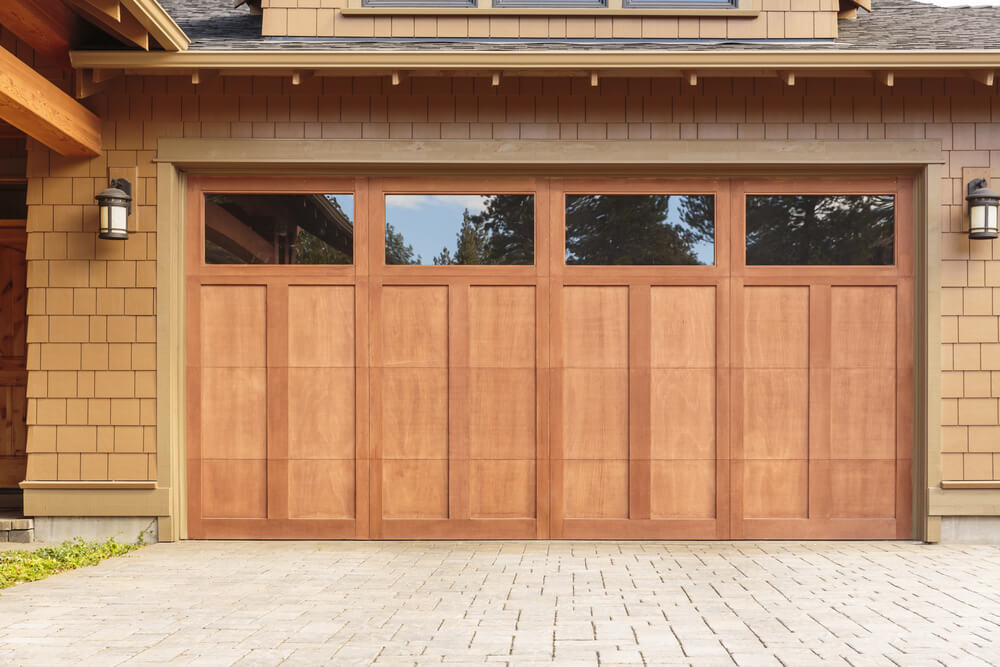How Do Overhead Garage Doors Work?


Using a complex interplay of counterweights, springs, and cables, an overhead garage door might seem a little confusing. Before we can jump into how these system work let us first take a step back and look at the history and different types of garage doors.
The term garage didn’t enter the English dictionary until 1902 – many of these early models were just leftover from carriage days. The modern garage doors started being implemented in the 1920s with the creation of the first overhead model.
Aside from the traditional overhead door, there is a variety of different models available. Sectional doors can have windows, swing-style or carriage doors look like a pair of large French doors. There are also roll-up doors that bend in multiple parts and roll up into the ceiling.
While no longer the most common, wood garage doors are still found here and there. More modern materials are more common though – composite models that look like wood, lightweight aluminum, the tough steel, and even the more contemporary glass to name a few.
A garage door isn’t just merely a chunk of material – their many different pieces that work in conjunction with one another. There is the spring system, hinges, rollers, and cable or chain. There is also the motorhead and light sensors for those that have a garage door opener.
According to Discount Garage Door, who can help if you need to repair or get a new overhead door in Tulsa, OK, an overhead garage door works roughly with a counterbalance system. Using a weight to counterbalance the actual weight of the door. There are roughly two types of systems that use this, the extension spring and torsion spring system.
The extension spring system works by pulling the door open from the bottom. The springs, attached on one end to the cables and the other end to the bottom of the door, stretch when the door is closed. The tension is then released to bring the door back into an overhead position.
More common than the extension springs, the torsion spring system. This setup uses the springs horizontally. Like the previous system, the strings stretch when the door is closed and recede when it is opened – the difference is that the cables are attached to the bottom instead.
Think of a seesaw with two equal weighted people on each side – moving up and down is easy with just a little bit of locomotion. A similar principle holds with garage doors – typically using a pair of weights equal to the weight of the garage door to pull it upwards.
Not exactly, as the pulley system that uses springs and cables are able to create enough tension to lift up a door without the exact amount of weight. This often works by building the tension, resulting in a much smaller weight being double, triple, or more counted when lifting.
Easy, imagine a drum located at the top of your garage attached to a cable. On the other end of the cable is a weight, let’s say 100 pounds. If the cable is wrapped around the drum four times, that means there is 400 pounds of tension – enough weight to pull up the 400-pound door.
Yes actually. While the above represents the majority of residential applications, sometimes factory or industrial systems have varying setups. The most common of these variants are the vertical lift system and the high-lift system.
Instead of going right overhead onto the ceiling, this system pulls the garage door directly up. The overall setup of this vertical lift has to vary from the traditional way – for one, the drum that the cable wraps around has to be tapered rather than completely uniform.
Think of it as a hybrid of both the vertical lift and the standard lift systems – using a half tapered half flat drum, this allows for the door to be lifted vertically for part of the distance, with the rest of it being sucked to the ceiling.
There are many different types of garage door types and materials – when it comes to overhead models they can be roughly divided up into three systems. The standard lift system is the most common but there are vertical and high-lift variants out there as well.
Henry Killingsworth
It stood out to me when you mentioned that sectional garage doors can have windows. If you are getting a garage door with windows, I would think that it would be important to make sure that they are multi-layered windows. You would want a door with multi-layered windows so that it doesn’t get too hot in your garage. https://www.macarthurgarages.com.au/products